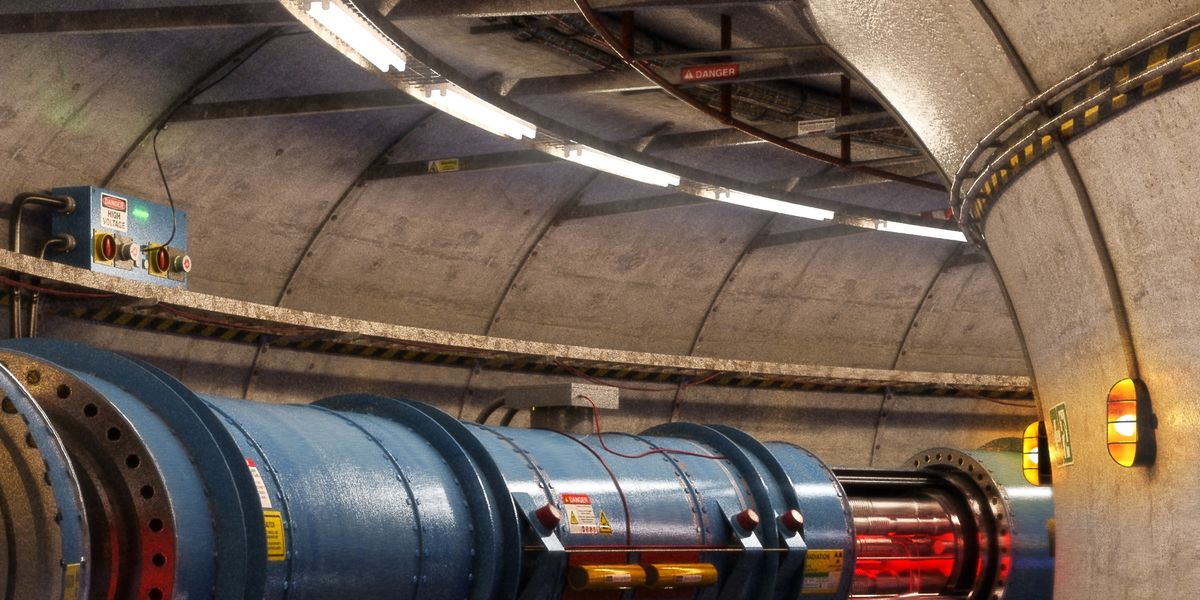
An invisible force has long eluded detection within the halls of the world’s most famous particle accelerator—until now.
- CERN’s Super Proton Synchrotron will turn 50 in 2026—and it has a resonant “ghost.”
- Using mathematics, physicists measured and modeled how these resonant lines intersect.
- Modeling a 3D shape over time requires a 4D system of equations.
In new research published in the journal Nature Physics, scientists at CERN in Switzerland and Goethe University Frankfurt in Germany announced that they had isolated a resonant “ghost” that affects how particles behave inside the Super Proton Synchotron (SPS). It’s a 3D shape that shifts over time, meaning it’s best measured in 4D. And the secret is the same reason you spill your coffee walking back to your desk, or super-bounce your friends off the trampoline.
The SPS is a ring that’s nearly four miles across, dating back to the 1970s. That sounds like ancient history, but the SPS has remained vital at CERN. In 2019, it received an upgraded “beam dump,” which is like the runaway truck ramp for the high-powered beams inside the SPS. So, when researchers noticed the ghost in the machine, so to speak, they knew it was important to map and understand for future work.
The ghost is caused by resonance. When things have energy and make waves, those waves can interact with each other and create weird little loci where energy is amplified. When you walk with coffee, each step creates waves in the liquid that eventually meet each other and spill over. On the trampoline, one person jumps “into” another person’s jump and is resonated into a much higher jump. And in the SPS, spilling your harmonic coffee means losing essential photons in what is known as beam degradation.
“In accelerator physics, an understanding of resonances and nonlinear dynamics is crucial for avoiding the loss of beam particles,” the sceintists explain in the paper. And how complicated it is grows as the problem in question gains more moving parts and more “degrees of freedom.” Each moving part, including the connectors, generates its own vibrations.
Beam degradation is a huge problem, especially as the proton beams in question grow more and more energized and robust. And harmonics in complex systems affect any experiment where particles interact inside a vessel—like nuclear fusion research in tokamaks. Harmonic interference, therefore, is also a huge problem in trying to reach productive nuclear fusion, creating dead spots where the stream of energy can lose vital heat energy.
Inside the SPS, particles only have two degrees of freedom, which doesn’t sound so complex. Like the photons inside a fiber optic line, these SLS photons are traveling in an overall path. But they can also “bounce” within that path, because even a narrow beam or cable still has thickness. SPS isn’t a thick donut, but it is still a real life donut, rather than a circle in a geometry book illustration.
And that “bounce” is distorted because of the human and reality factors. The SPS may be one of the premiere facilities in the world, but everything in science has to be made with what we have. Magnets that power these facilities are imperfect, and even tiny fluctuations in magnetism can cause resonance. To quantify this, the researchers took measurements from around the SPS ring and used the data to build a math model called a Poincaré section.
In a Poincaré section, you stabilize one element (in this case, a “fixed line” the researchers mention in their paper) and step through a system, mapping all the intersections of the other elements, until you form an entire “surface.” The results are like an MRI but for a dynamic system, whose shape may change with each step—and, in this case, with the addition of time as the fourth dimension. And since the resonance in a closed system like the SPS ends up repeating, the 4D surface study can loop like a well-made GIF.
In their mathematics, the team found that fixed lines could predict where particles would gather up. By taking the time to study and model the phenomenon, they hope to help researchers who develop strategies to dampen the effect of these fixed harmonic lines. The work could also help those constructing new particle accelerators work to avoid creating magnet “ghosts” in the first place, which could save a lot of money by keeping beams and data more intact, and delivering higher quality results with less work.
The 2023 Popular Mechanics Automotive Excellence Awards: EVs
News Related-
Russian court extends detention of Wall Street Journal reporter Gershkovich until end of January
-
Russian court extends detention of Wall Street Journal reporter Evan Gershkovich, arrested on espionage charges
-
Israel's economy recovered from previous wars with Hamas, but this one might go longer, hit harder
-
Stock market today: Asian shares mixed ahead of US consumer confidence and price data
-
EXCLUSIVE: ‘Sister Wives' star Christine Brown says her kids' happy marriages inspired her leave Kody Brown
-
NBA fans roast Clippers for losing to Nuggets without Jokic, Murray, Gordon
-
Panthers-Senators brawl ends in 10-minute penalty for all players on ice
-
CNBC Daily Open: Is record Black Friday sales spike a false dawn?
-
Freed Israeli hostage describes deteriorating conditions while being held by Hamas
-
High stakes and glitz mark the vote in Paris for the 2030 World Expo host
-
Biden’s unworkable nursing rule will harm seniors
-
Jalen Hurts: We did what we needed to do when it mattered the most
-
LeBron James takes NBA all-time minutes lead in career-worst loss
-
Vikings' Kevin O'Connell to evaluate Josh Dobbs, path forward at QB
